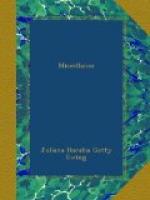Among those products of the palm which we import most liberally is “vegetable ivory.”
Vegetable ivory is the kernel of the fruit of one of the most beautiful of palms (Phytelephas macrocarpa).
This Prince of Vegetation is a native of South America. “It is short-stemmed and procumbent, but has a magnificent crown of light green ostrich-feather-like leaves, which rise from thirty to forty feet high.” The fruit is as big as a man’s head. Two or three millions of the nuts are imported by us every year, and applied to all the purposes of use and ornament for which real ivory is available.
The Coquilla-nut palm (Attalea funifera), whose fruit is about the size of an ostrich-egg, also supplies a kind of vegetable ivory.
Our ideas of palm-trees are so much derived from the date palm of Judaea, that an erect and stately growth is probably inseparably connected in our minds with the Princes of Vegetation. But some of the most beautiful are short-stemmed and creeping; whilst others fling giant arms from tree to tree of the tropical forests, now drooping to the ground, and then climbing up again in very luxuriance of growth. Many of the rattan palms (Calamus) are of this character. They wind in and out, hanging in festoons from the branches, on which they lean in princely condescension, with stems upwards of a thousand feet in length.
There is something comical in having to add that these clinging rattan stems, which cannot support their own weight, have a proverbial fame, and are in great request for the manufacture of walking-sticks. They are also largely imported into Great Britain for canework.
Another very striking genus (Astrocaryum) is remarkable for being clothed in every part—stem, leaves, and spathe—with sharp spines, which are sometimes twelve inches long. Astrocaryum murumura is edible. The pulp of the fruit is said to be like that of a melon, and it has a musky odour. It is a native of tropical America, and abundant on the Amazon. Cattle wander about the forests in search of it, and pigs fatten on the nut, which they crunch with their teeth, though it is exceedingly hard.
The date palm yields a wine called toddy, or palm wine, and from the Princes of Vegetation is also distilled a strong spirit called arrack.
And speaking again of the Judaean palms, I must here say a word of those which we associate with Palm Sunday—the willow palms—for which we used to hunt when we were children.
It is hardly necessary to state that these willow branches, with their soft silvery catkins, the crown of the earliest spring nosegays which the hedges afford, are not even distantly related to the Princes of Vegetation, though we call them palms. They are called palms simply from having taken the place of real palm-branches in the ceremonies of the Sunday of our Lord’s Entry into Jerusalem, where these do not grow.




